Abbreviation Sgr Declination −25 Messier object 15 Stars with planets 32 | Genitive Sagittarii Right ascension 19 Bayer/Flamsteed designation 68 Stars brighter than 3.00m 7 | |
 | ||
Pronunciation /ˌsædʒᵻˈteɪriəs/, genitive /ˌsædʒᵻˈteɪri.aɪ/ Similar Capricornus, Scorpius, Libra, Gemini, Aquarius | ||
Sagittarius is one of the constellations of the zodiac. It is one of the 48 constellations listed by the 2nd-century astronomer Ptolemy and remains one of the 88 modern constellations. Its name is Latin for the archer, and its symbol is (Unicode U+2650 ♐), a stylized arrow. Sagittarius A*is commonly represented as a centaur pulling-back a bow. It lies between Scorpius and Ophiuchus to the west and Capricornus to the east.
Contents
- Visualizations
- Stars
- Deep Space objects
- Nebulae
- Other deep sky objects
- Exploration
- Mythology
- Greek mythology
- Astrology
- References
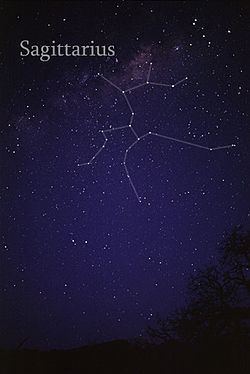
The center of the Milky Way lies in the westernmost part of Sagittarius (see Sagittarius A).
Visualizations
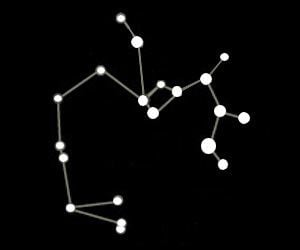
As seen from the northern hemisphere, the constellation's brighter stars form an easily recognizable asterism known as 'the Teapot'. The stars δ Sgr (Kaus Media), ε Sgr (Kaus Australis), ζ Sgr (Ascella), and φ Sgr form the body of the pot; λ Sgr (Kaus Borealis) is the point of the lid; γ2 Sgr (Alnasl) is the tip of the spout; and σ Sgr (Nunki) and τ Sgr the handle. These same stars originally formed the bow and arrow of Sagittarius.
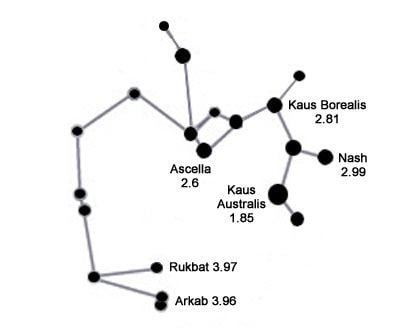
Marking the bottom of the teapot's "handle" (or the shoulder area of the archer, are the bright star (2.59 magnitude) Zeta Sagittarii (ζ Sgr), named Ascella, and the fainter Tau Sagittarii (τ Sgr).
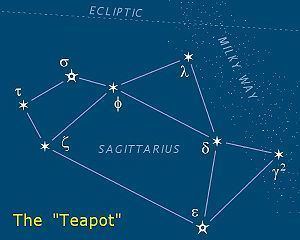
To complete the teapot metaphor, under good conditions, a particularly dense area of the Milky Way can be seen rising in a north-westerly arc above the spout, like a puff of steam rising from a boiling kettle.
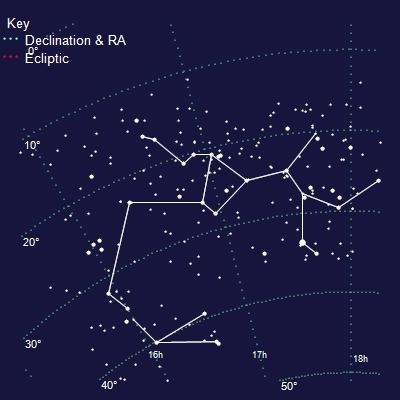
The constellation as a whole is often depicted as having the rough appearance of a stick-figure archer drawing its bow, with the fainter stars providing the outline of the horse's body. Sagittarius A*famously points its arrow at the heart of Scorpius, represented by the reddish star Antares, as the two constellations race around the sky. Following the direct line formed by Delta Sagittarii (δ Sgr) and Gamma2 Sagittarii (γ2 Sgr) leads nearly directly to Antares. Fittingly, Sagittarii is Alnasl, the Arabic word for "arrowhead", and Delta Sagittarii is called Kaus Media, the "center of the bow," from which the arrow protrudes. Kaus Media bisects Lambda Sagittarii (λ Sgr) and Epsilon Sagittarii (ε Sgr), whose names Kaus Borealis and Kaus Australis refer to the northern and southern portions of the bow, respectively.
Stars
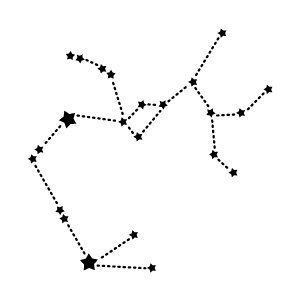
α Sgr (Rukbat, meaning "the archer's knee") despite having the "alpha" appellation, is not the brightest star of the constellation, having a magnitude of only 3.96 (not shown on the main map as it is located below the map's southeastern corner, north is up). Instead, the brightest star is Epsilon Sagittarii (ε Sgr) ("Kaus Australis," or "southern part of the bow"), at magnitude 1.85.
Sigma Sagittarii (σ Sgr) ("Nunki") is the constellation's second-brightest star at magnitude 2.08. Nunki is a B2V star approximately 260 light years away. "Nunki" is a Babylonian name of uncertain origin, but thought to represent the sacred Babylonian city of Eridu on the Euphrates, which would make Nunki the oldest star name currently in use.
Zeta Sagittarii (ζ Sgr) ("Ascella"), with apparent magnitude 2.61 of A2 spectra, is actually a double star whose two components have magnitudes 3.3 and 3.5.
Delta Sagittarii (δ Sgr) ("Kaus Meridionalis"), is a K2 spectra star with magnitude 2.71 and only 85 light years from Earth.
Eta Sagittarii (η Sgr) is a double star with component magnitudes of 3.18 and 10, while Pi Sagittarii (π Sgr) is actually a triple system whose components have magnitudes 3.7, 3.8, and 6.0.
The Bayer designation Beta Sagittarii (Beta Sgr, β Sagittarii, β Sgr) is shared by two star systems, β¹ Sagittarii, with apparent magnitude 3.96, and β² Sagittarii, magnitude 7.4. The two stars are separated by 0.36° in the sky and are 378 light years from earth. Beta Sagittarii, located at a position associated with the forelegs of the centaur, has the traditional name Arkab, meaning "achilles tendon."
Nova Sagittarii 2015 No. 2 was discovered on March 15, 2015, by John Seach of Chatsworth Island, NSW, Australia. It lies near the center of the constellation. It reached a peak magnitude of 4.3 before steadily fading.
Deep-Space objects
The Milky Way is at its densest near Sagittarius, as this is where the galactic center lies. As a result, Sagittarius contains many star clusters and nebulae.
Nebulae
Sagittarius contains several well-known nebulae, including the Lagoon Nebula (Messier 8), near λ Sagittarii; the Omega Nebula (Messier 17), also known as the Horseshoe Nebula or Swan Nebula, near the border with Scutum; and the Trifid Nebula (Messier 20), a large nebula containing some very young, hot stars.
The grouping of the Lagoon Nebula, the Trifid Nebula, and NGC 6559 is often called the Sagittarius triplet.
In addition, several other nebulae have been located within Sagittarius and are of interest to astronomers.
Other deep sky objects
In 1999 a violent outburst at V4641 Sgr was thought to have revealed the location of the closest known black hole to Earth, but later investigation increased its estimated distance by a factor of 15. The complex radio source Sagittarius A is also in Sagittarius, near its western boundary with Ophiuchus. Astronomers believe that one of its components, known as Sagittarius A*, is associated with a supermassive black hole at the center of the galaxy, with a mass of 2.6 million solar masses. The Sagittarius Dwarf Elliptical Galaxy is located just outside the Milky Way.
Baade's Window is an area with very little obscuring dust that shows objects closer to the Milky Way's center than would normally be visible. NGC 6522, magnitude 8.6, and NGC 6528, magnitude 9.5, are both globular clusters visible through Baade's Window. 20,000 and 24,000 light-years from Earth, with Shapley classes of VI and V respectively, both are moderately concentrated at their cores. NGC 6528 is closer to the galactic core at an approximate distance of 2,000 light-years.
Exploration
The space probe New Horizons is moving on a trajectory out of the Solar System as of 2016 that places the probe in front of Sagittarius as seen from the Earth. New Horizons will exhaust its radioisotope thermoelectric generator long before it reaches any other stars.
The Wow! signal was a strong narrowband radio signal that appeared to have come from the direction of Sagittarius.
Mythology
The Babylonians identified Sagittarius as the god Nergal, a strange centaur-like creature firing an arrow from a bow. It is generally depicted with wings, with two heads, one panther head and one human head, as well as a scorpion's stinger raised above its more conventional horse's tail. The Sumerian name Pabilsag is composed of two elements – Pabil, meaning 'elder paternal kinsman' and Sag, meaning 'chief, head'. The name may thus be translated as the 'Forefather' or 'Chief Ancestor'. The figure is reminiscent of modern depictions of Sagittarius.
Greek mythology
In Greek mythology, Sagittarius is usually identified as a centaur: half human, half horse. However, perhaps due to the Greeks' adoption of the Sumerian constellation, some confusion surrounds the identity of the archer. Some identify Sagittarius as the centaur Chiron, the son of Philyra and Saturn and tutor to Jason, who was said to have changed himself into a horse to escape his jealous wife, Rhea. However, some identify Chiron with the constellation Centaurus, the other heavenly centaur. An alternative tradition is that Chiron merely invented the constellation Sagittarius to help in guiding the Argonauts in their quest for the Golden Fleece.
A competing mythological tradition, as espoused by Eratosthenes, identified the Archer not as a centaur but as the satyr Crotus, son of Pan, who Greeks credited with the invention of archery. According to myth, Crotus often went hunting on horseback and lived among the Muses, who requested that Zeus place him in the sky, where he is seen demonstrating archery.
The arrow of this constellation points towards the star Antares, the "heart of the scorpion," and Sagittarius stands poised to attack should Scorpius ever attack the nearby Hercules, or to avenge Scorpius's slaying of Orion.
Astrology
As of 2002, the Sun appears in the constellation Sagittarius from 18 December to 18 January. In tropical astrology, the Sun is considered to be in the sign Sagittarius from 22 November to 21 December, and in sidereal astrology, from 16 December to 14 January.
